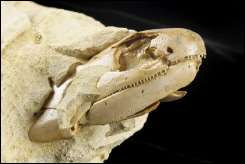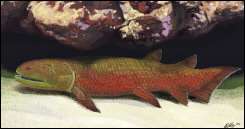Fossil fish fills evolutionary gap

The discovery of a perfectly preserved fish fossil by Australian researchers has added further weight to the theory that ancient four-legged animals (tetrapods) may have first moved onto the land in Australia, rather than in the Northern Hemisphere as previously assumed.
In Nature today, researchers from Museum Victoria, The Australian National University, and Monash University, have revealed unprecedented details of a fossilised Gogonasus – a primitive fish that lived in a shallow coral reef environment in north-western Australia about 370 million years ago.
“The transition from fishes to tetrapods was one of the most dramatic events in the evolution of vertebrates, but many pivotal fossils are incomplete, resulting in gaps in our understanding of how animals came to inhabit the land – but this find helps us fill in the gaps,” Head of Sciences at Museum Victoria Dr John Long said.
The revealing Gogonasus fossil was found by Dr Tim Senden from the Department of Applied Mathematics, ANU, during a research trip to Western Australia last year. The skeleton was acid-etched from the rock at Museum Victoria, and scanned by Dr Senden using the 3D X-ray microscope at ANU to show the creature’s skeletal structure in amazing detail.

“As well as its advanced middle ear structure, tending towards the condition in land animals, the new study reveals that the fleshy lobes in the fins of Gogonasus were the precursors to land-based limbs,” said Dr Gavin Young, from the Department of Earth and Marine Sciences at ANU.
“Previous reports have tended to focus on the evidence of animals moving onto the land in the Northern Hemisphere, while some of our Australian fossils have gone under-reported. We know that tetrapods were already living in Australia around 370 million years ago, because of trackways preserved in rocks of this age in Victoria, and a single tetrapod jaw discovered years ago near Forbes in central NSW. Large areas of rock strata of the right age in Australia are still unexplored. We are searching these to find additional fossil evidence of the first land animals to have inhabited the southern hemisphere continents.”
The Gogonasus research forms part of an Australian Research Council Discovery Project based at ANU and led by Dr Young. The new Gogonasus specimen will be on public display at Melbourne Museum until 19 November.
Source: Australian National University

















